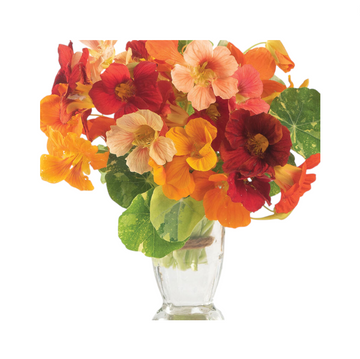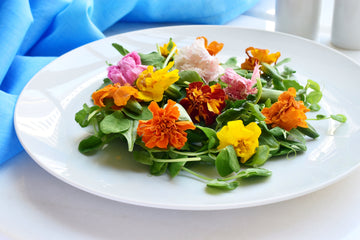Nasturtium Alaskan

Freshly Harvested

Non-GMO & Natural

Nutrient Dense

Trusted by Chefs
10 Seeds+
🌸 Nasturtium ‘Alaska’ Flower Seeds
Tropaeolum majus
A garden and kitchen favorite 🌿✨, Nasturtium ‘Alaska’ combines striking, variegated foliage 💚🤍 with bold edible blooms in shades of red ❤️, orange 🧡, and yellow 💛. Compact and easy to grow, it thrives in poor soils, blooms abundantly, and delivers both visual appeal and peppery flavor 🌶️. A true multitasker — decorative, edible, and a natural pest deterrent.
👅 Flavor Profile:
Peppery 🌶️, mustard-like 🌿, with hints of radish crunch 🥗.
🍴 Culinary Uses:
🥗 Toss petals into salads for color + a peppery bite
🥒 Use leaves as edible wraps or add to sandwiches for spice
🍸 Float flowers in cocktails for fiery flair
🧄 Pickle seed pods (“poor man’s capers”) for gourmet condiments
🧁 Garnish cakes and savory plates with bold edible blooms
👨🍳 Chef’s Pitch:
Nasturtium ‘Alaska’ is the chef’s edible firework 🌸👨🍳🔥. Its variegated foliage and bright blooms double as garnish and seasoning, delivering peppery zip to salads, sauces, and cocktails. Plus, the seed pods are a gourmet secret — a sustainable caper substitute for creative kitchens.
🌱 Growing Notes:
🪴 Annual, trailing or mounding habit, 10–12” tall
🌸 Bright red, orange & yellow blooms with marbled leaves
🌞 Thrives in poor to average soil, full sun → part shade
⏱ Long bloom season: summer → frost
🐝 Pollinator-friendly + natural pest deterrent (aphids love them as trap plants)
✨ Quick Facts:
-
Latin Name: Tropaeolum majus (‘Alaska’)
-
Habit: Annual, 10–12” compact, trailing/mounding
-
Flavor: Peppery, mustard-like, radish-like
-
Culinary Uses: Salads, sandwiches, cocktails, pickled seed pods
-
Special Use: Variegated foliage + edible blooms + pest control

Nasturtium Alaskan

Let’s Manifest Beauty.
Edible Flowers that Smile.
Edible flowers are more than just decoration — they’re a chef’s secret for adding elegance, fragrance, and subtle flavor to a dish. From citrusy marigolds to honey-sweet alyssum and tangy begonias, these delicate blooms transform plates into experiences. Each petal offers color, aroma, and taste, turning simple ingredients into a culinary statement.

Flowers are here to stay
The Art of Garnishing with Edible Flowers
A garnish should do more than decorate — it should enhance. Edible flowers bring color, fragrance, and subtle flavor to the plate, turning simple dishes into memorable experiences. From delicate petals scattered across a salad to a single bloom crowning a dessert, flowers add elegance and elevate presentation in ways that engage every sense.
The Secret Ingredient Chefs Trust
Widely used in professional kitchens, microgreens enhance flavor profiles while adding nutrition and a striking visual appeal to everything from sandwiches to fine dining creations.
Frequent Asked Questions
Q: What are Microgreens?
Microgreens are young, tender plants harvested just after the first leaves develop. They’re packed with flavor, color, and nutrients, making them both delicious and healthy.
Q: Are microgreens really more nutritious than regular vegetables?
Yes. Research shows that microgreens can contain up to 40x more vitamins and antioxidants (like A, C, K, and E) compared to their mature counterparts.
Q: How do I use microgreens in my meals?
They’re incredibly versatile—use them as a garnish, in salads, on sandwiches, in wraps, smoothies, soups, or even as a centerpiece ingredient in gourmet dishes.
Q: How long do microgreens stay fresh?
Stored properly in a fridge, microgreens typically last 5–7 days. To keep them at peak freshness, store them dry in a breathable container.









